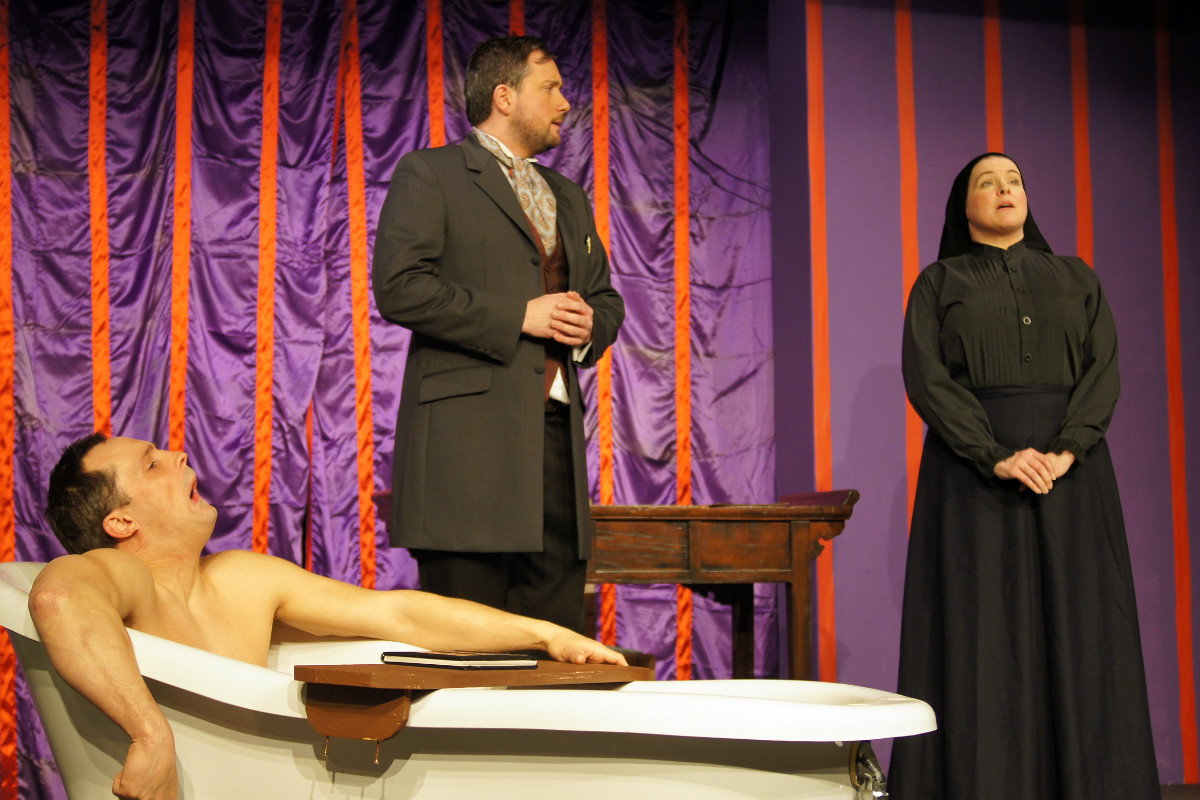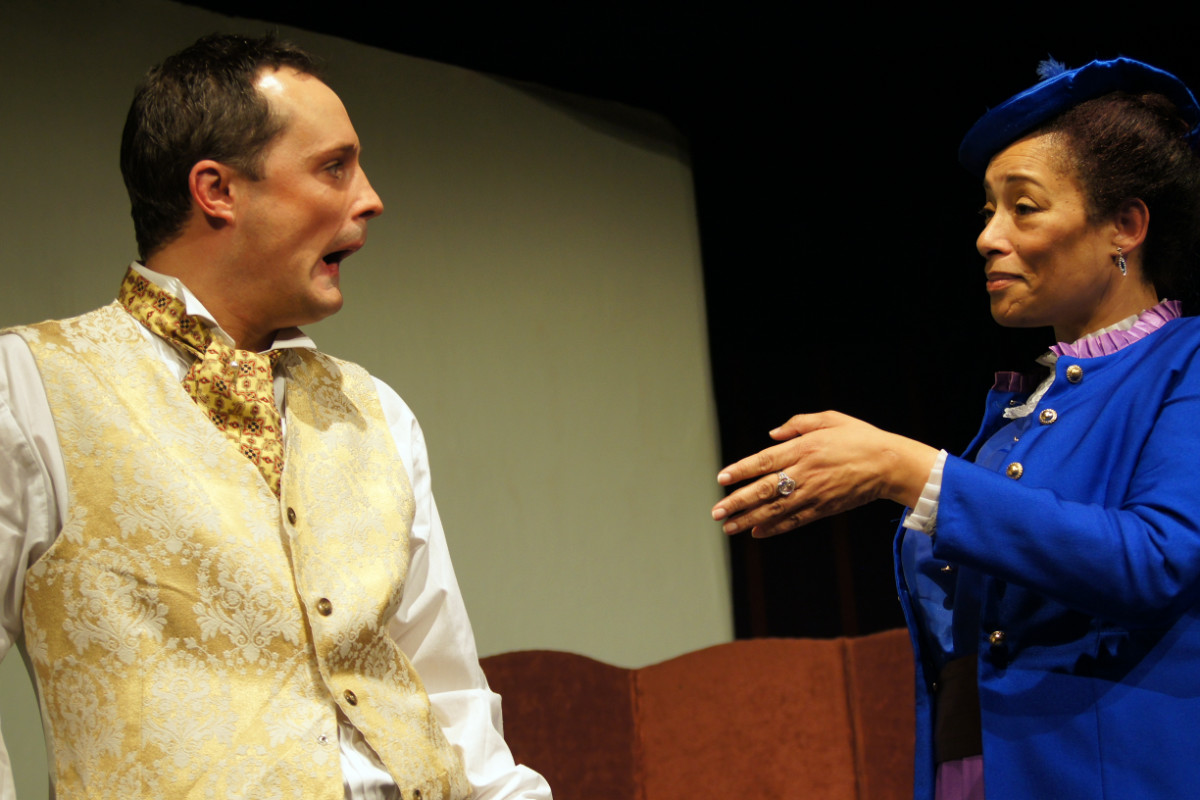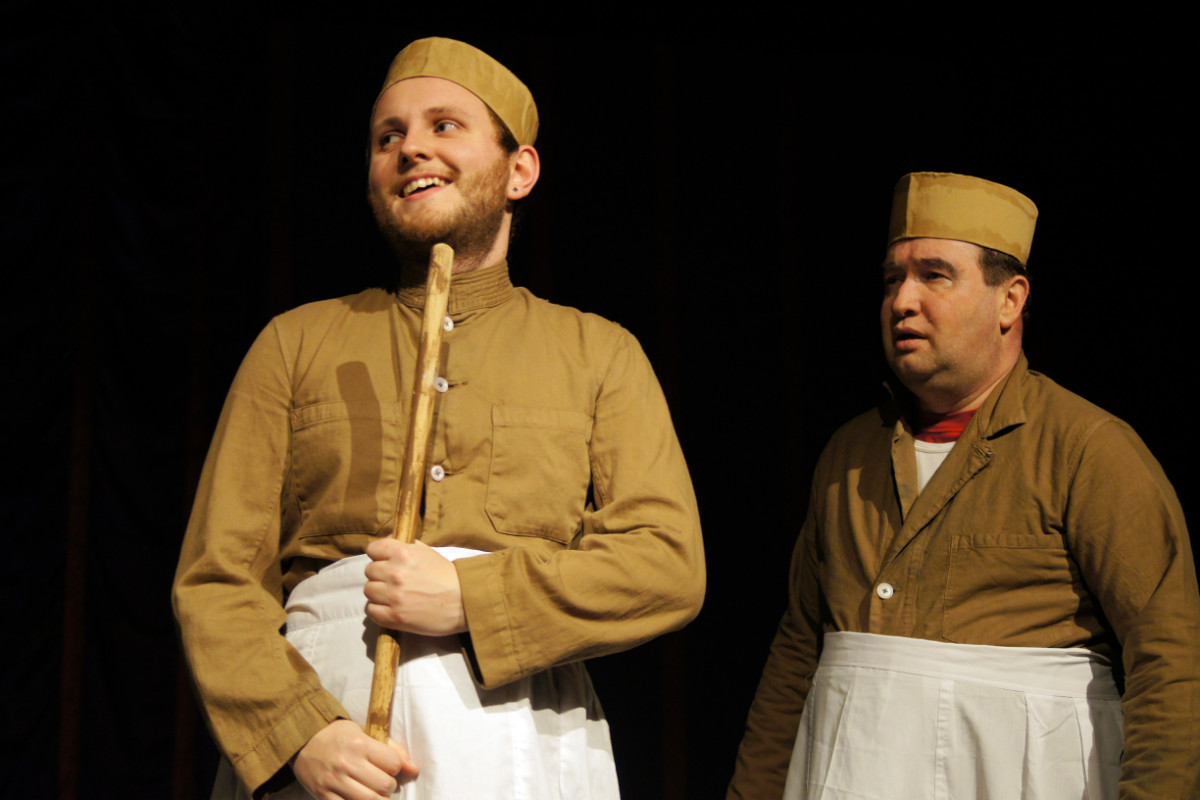|
|
|||||||||||||||||||||||||||||||||||||||||||||||||||||||||||||||||||||||||||
Click
here for more pictures of this play |
|||||||||||||||||||||||||||||||||||||||||||||||||||||||||||||||||||||||||||
|
|||||||||||||||||||||||||||||||||||||||||||||||||||||||||||||||||||||||||||
|
National Operatic & Dramatic Association London Region
Show Report Once again, I was delighted to be asked to write the report on your latest production, a story which the majority of people in the audience possibly knew to varying degrees, but which, when written as a play by Bernard Pomerance and performed by such an experienced cast, took on a whole new depth of meaning. I must congratulate your selection committee for striving to bring to your audiences plays of such varied subject matter and challenging dramatic interpretation, as well as providing excellent ‘entertainment’. I have mentioned before that I always find the background piece and the Director’s notes in your programme so informative and, indeed, this was no exception. In this case, though, it was enlightening to read that there have been so many conflicting reports of Joseph Merrick’s life that to try and get a true perspective was a challenge in itself. A challenge to which Jean Cooper, the Director, rose magnificently! When a play is based on facts there is, I believe, a duty on behalf of the entire cast to be as truthful as possible, and I think this must have been the hardest challenge for the Director. Thanks to Howard Platt for his continued work with the programme and poster design - most evocative on both counts. As always, I will start with the technical side of the production, which in this case, particularly, added so much thus enabling the audience to understand the social history of the time in which the play is set. The simple staging and the use of lighting to denote various scenes enabled the play to move smoothly without the need for a lot of scene shifting. Well done to Stephen Radley for his design and construction, both of which worked well. I was rather surprised, though, that there were a few times when the change from one scene to another took longer than one would have expected. Victorian London, as depicted on the projected photographs, takes quite a bit of understanding. The projections – London itself, the workhouse and the actual photographs of Joseph Merrick all helped us to appreciate the atmosphere and attitudes of the time. I don’t know who was responsible for ensuring the projections were on cue and well lit – but congratulations…most effective. Both in London and Belgium, at this time, there was little done to understand those members of society who were incarcerated in an asylum or had the physical afflictions, like Merrick. The ‘soundtrack’ of the fairground as the audience entered, with the music and the hubbub of voices, lent a very jolly atmosphere to the start of the play which actually belied the humiliation which those less able persons suffered at the hands of the showmen. Well done to Terry Tew for Lighting Design and Andrew Rogers for the Sound Design. I always think that the music used throughout your productions is eminently suitable and this was no exception. The Sound and Lighting Operation worked so smoothly too – I’m not sure whether this was Cathy Naylor or actually Sarah Biggs – I would imagine a lot of concentration is needed for both these roles. Costumes, in the capable hands of Liz Adams, were well thought through, and most suitable for each of the characters concerned, in some cases emphasising their social status. I can actually remember the long-skirted uniforms that the nurses in the London Hospital used to wear! What a difference it made to Merrick’s appearance when we saw him in a shirt and brocade waistcoat, and how well the longer right hand sleeve worked in giving us the impression of a deformed, hidden hand. The Pinheads had their condition exaggerated by the white conical shapes on their heads, although it is doubtful whether their heads would actually have been quite that shape, but given their possible condition of microcephaly, they would have been smaller and more pointed than normal, and the cones would have been a useful freak show ‘prop’. Properties for this Victorian era were well sourced by Val Jones and Portia Sorinyana. Merrick’s model in its various stages of construction was one which fascinated me – and how different you made his hospital room look once it was established as his home. Congratulations to the entire production team for enabling this production to have such a profound effect on the audience. And so to the cast!! Once again some really first class portrayals with a mixture of both new and established performers. The doubling of some of the characters worked extremely well with each of the characters being clearly defined – in the case of the pinheads they were unrecognisable when they became members of the aristocracy. So…if I may…I will take the cast in the order in which they appear in the programme. As John Merrick, the Elephant Man himself, Christian Mortimer used his physicality to marvellous effect. As he stood on the stage whilst his image was projected and his condition was related to the audience, he changed before our eyes until he became the person with the malformed physique. This enabled each of us to have our own perception of what Merrick looked like, and the fact that Christian maintained those abnormalities throughout his performance meant that we also maintained that perception throughout the production. We were also able to see and understand, how he changed under Treeves’ protection, although there was always the glimpse of the man inside. He grew in confidence and assurance before our eyes and delighted in the attentions of those notable persons who were his frequent visitors. Those insights into his intelligence, sensitivity and sense of humour were so wonderfully low-key and surprising. Frederick Treeves (Tom Donoghue) was a young doctor willing to fight for those less fortunate and his dedication and concern for Merrick seemed to define his life. His performance was sensitive, and his relationship with Merrick protective, although as the play progressed we see a change in his attitude to healing the sick poor and the aristocracy – a theme which I understand many medics experience throughout their career. Tom’s dialogue was clear, precise and secure and his relationship with the other characters very believable. I understand this is possibly the biggest role you have taken with LADS, but if you could physically relax on the stage I think your performance would benefit greatly. The character of Carr Gomm was in the very capable hands of Howard Platt. A man at the top of his profession and possibly on the governing board of the London Hospital, he shared Treeves’ compassion for Merrick and his high principles, but was worldly enough to see through Lord John and advise accordingly. Howard’s portrayal had authority and kindness and an understanding of the high ideals which filled Treeves’ early career. He completely looked the part throughout and showed us a sympathetic understanding of Merrick’s limited life expectancy. Mrs Kendall (Amanda Smith) was a delightful companion for Merrick. She showed no disdain for his condition and was so kind and generous with her time. As an actress she would have been adept at concealing any negative feelings she may have felt for Merrick’s condition, but there was never a time when I didn’t believe she could see beyond his physicality. She also understood the man inside and knew how to deal with it. Her performance was pitched just right – she was the same with duchesses and countesses as she was with Merrick – and showed a great affection for this unfortunate man, without a hint of pity. Peter Fox showed us two very different characters in Ross and Lord John – the change in costume leaving us in no doubt as to which was which. I think Ross was the personification of the freak show men of the time, with his eye on the main chance, but with a streak of self-preservation as when he approached Merrick for his ‘cut’ when he found himself short of cash. A well played ‘wide boy’ of the Victorian era. As Lord John he played a similar wide boy but from the aristocracy. Bishop How (Richard Cohen) was the voice of reason both in his dealings with Treeves and Carr Gomm and was played with strong humanitarian conviction and a believable pastoral air. I put Snork (Marcel Kay) and the Porter (Joshua Sowerbutts) together because they were probably two of the lowest ranked workers in the hospital and their attitude to their jobs was similar. These two characters allowed us to see the differences in attitude and behaviour within the ranks of the non-professional staff in the hospital. The Pinheads (Jo Keen, Wendy Butler and Val Jones) portrayed these poor creatures whose greatest fear was a return to the asylum. They were verging on hysteria and visibly terrified of their manager (Marcel Kay) – a rather unsettling glimpse of their life in a freak show. Elisa Thomas played the part of Miss Sandwich with conviction and belief in her own ability to deal with the upsetting sight of Merrick – until it was actually put to the test. She was also suitably regal, but this time very kind, when she met Merrick as Princess Alexandra, together with Duchess (Jo Keen) and Countess (Wendy Butler). Charlotte Pope was a very convincing Nurse - with her authentic uniform and air of quiet efficiency. And the Belgian and English Policemen were played by Richard Cohen and Martin Howarth respectively. Initially this would appear to be a play with primarily three main parts, but all the other characters added so much to the overall feel that it is difficult to imagine the story/play without them. They all impacted on Merrick’s life in one way or another and in varying degrees. Treeves’ dream was an example of the way Merrick, and his own attitude to the poor man, had affected his thinking and to see Merrick playing the part that Treeves had played when they first met felt quite surreal. Although it was very obvious that John Merrick was not going to have a long life, even in the caring atmosphere of the hospital, his death, when it came, was very sensitively handled. From what I understand his one wish was to sleep lying down as other men, so one could almost say that he chose his own way to go if Pomerance’s play is to be believed. In your depiction of this story there was pathos, humanity and sensitivity, but above all there was humour which prevented it being a maudlin evening, but one where hope and humanity reigned supreme. Congratulations to you all - I hope that you had the audiences a play of this calibre deserves. Jacquie Stedman |
|||||||||||||||||||||||||||||||||||||||||||||||||||||||||||||||||||||||||||




